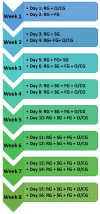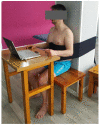Feasibility and Efficacy of a Virtual Reality Game-Based Upper Extremity Motor Function Rehabilitation Therapy in Patients with Chronic Stroke: A Pilot Study
- PMID: 35329069
- PMCID: PMC8948798
- DOI: 10.3390/ijerph19063381
Feasibility and Efficacy of a Virtual Reality Game-Based Upper Extremity Motor Function Rehabilitation Therapy in Patients with Chronic Stroke: A Pilot Study
Abstract
The objective of the present study was to develop a virtual reality protocol based on activities of daily living and conventional rehabilitation, using Leap Motion Controller to improve motor function in upper extremity rehabilitation in stroke patients. At the same time, the purpose was to explore its efficacy in the recovery of upper extremity motor function in chronic stroke survivors, and to determine feasibility, satisfaction and attendance rate; Methods: A prospective pilot experimental clinical trial was conducted. The outcome measures used were the grip strength, the Action Research Arm Test (ARAT), the Block and Box Test (BBT), the Short Form Health Survey-36 Questionnaire, a satisfaction questionnaire and attendance rate; Results: Our results showed statistically significant changes in the variables grip strength, BBT and ARAT as well as high levels of satisfaction and attendance; Conclusions: This virtual reality platform represents an effective tool in aspects of upper extremity functionality rehabilitation in patients with chronic stroke, demonstrating feasibility and high levels of attendance and satisfaction.
Keywords: neurorehabilitation; stroke; upper extremity; video games; virtual reality.
Conflict of interest statement
The authors declare no conflict of interest.
Figures
Similar articles
-
Commercial head-mounted display virtual reality for upper extremity rehabilitation in chronic stroke: a single-case design study.J Neuroeng Rehabil. 2020 Nov 23;17(1):154. doi: 10.1186/s12984-020-00788-x. J Neuroeng Rehabil. 2020. PMID: 33228710 Free PMC article. Clinical Trial.
-
Non-immersive Virtual Reality Rehabilitation Applied to a Task-oriented Approach for Stroke Patients: A Randomized Controlled Trial.Restor Neurol Neurosci. 2020;38(2):165-172. doi: 10.3233/RNN-190975. Restor Neurol Neurosci. 2020. PMID: 32176674 Clinical Trial.
-
Feasibility, Safety and Efficacy of a Virtual Reality Exergame System to Supplement Upper Extremity Rehabilitation Post-Stroke: A Pilot Randomized Clinical Trial and Proof of Principle.Int J Environ Res Public Health. 2019 Dec 23;17(1):113. doi: 10.3390/ijerph17010113. Int J Environ Res Public Health. 2019. PMID: 31877910 Free PMC article. Clinical Trial.
-
Effectiveness of Virtual Reality- and Gaming-Based Interventions for Upper Extremity Rehabilitation Poststroke: A Meta-analysis.Arch Phys Med Rehabil. 2020 May;101(5):885-896. doi: 10.1016/j.apmr.2019.10.195. Epub 2019 Dec 7. Arch Phys Med Rehabil. 2020. PMID: 31821799
-
Game-Based Virtual Reality Interventions to Improve Upper Limb Motor Function and Quality of Life After Stroke: Systematic Review and Meta-analysis.Games Health J. 2020 Feb;9(1):1-10. doi: 10.1089/g4h.2019.0043. Games Health J. 2020. PMID: 32027185
Cited by
-
Psychometric Properties of the Action Research Arm Test (ARAT) Scale in Post-Stroke Patients-Spanish Population.Int J Environ Res Public Health. 2022 Nov 13;19(22):14918. doi: 10.3390/ijerph192214918. Int J Environ Res Public Health. 2022. PMID: 36429637 Free PMC article.
-
The efficacy of virtual reality-based rehabilitation in improving motor function in patients with stroke: a systematic review and meta-analysis.Ann Med Surg (Lond). 2024 Aug 2;86(9):5425-5438. doi: 10.1097/MS9.0000000000002403. eCollection 2024 Sep. Ann Med Surg (Lond). 2024. PMID: 39238962 Free PMC article. Review.
-
Virtual reality-induced motor function of the upper extremity and brain activation in stroke: study protocol for a randomized controlled trial.Front Neurol. 2023 Apr 17;14:1094617. doi: 10.3389/fneur.2023.1094617. eCollection 2023. Front Neurol. 2023. PMID: 37139056 Free PMC article.
-
Telerehabilitation for upper limb disabilities: a scoping review on functions, outcomes, and evaluation methods.Arch Public Health. 2022 Aug 23;80(1):196. doi: 10.1186/s13690-022-00952-w. Arch Public Health. 2022. PMID: 35999548 Free PMC article.
-
Commercial device-based hand rehabilitation systems for stroke patients: State of the art and future prospects.Heliyon. 2023 Feb 10;9(3):e13588. doi: 10.1016/j.heliyon.2023.e13588. eCollection 2023 Mar. Heliyon. 2023. PMID: 36873497 Free PMC article. Review.
References
-
- De Neurologia S.E., Grupo de Estudio de Enfermedades Cerebrovasculares Sociedad Española de Neurología. El Atlas del Ictus España. 2019. [(accessed on 10 February 2021)]. Available online: https://www.sen.es/images/2020/atlas/Atlas_del_Ictus_de_Espana_version_w....
-
- Tran J.E., Fowler C.A., Delikat J., Kaplan H., Merzier M.M., Schlesinger M.R., Litzenberger S., Marszalek J.M., Scott S.L. Immersive Virtual Reality to Improve Outcomes in Veterans with Stroke: Protocol for a Single-Arm Pilot Study. JMIR Res. Protoc. 2021;10:e26133. doi: 10.2196/26133. - DOI - PMC - PubMed
-
- Bui J., Luauté J., Farnè A. Enhancing Upper Limb Rehabilitation of Stroke Patients with Virtual Reality: A Mini Review. Front. Virtual Real. 2021;2:146. doi: 10.3389/frvir.2021.595771. - DOI
-
- Cabeza Á.S. Terapia Ocupacional Para la Rehabilitación del Control Motor. EAE Editorial Academia Espanola; Chisinau, Moldova: 2012.
Publication types
MeSH terms
LinkOut - more resources
Full Text Sources
Medical




